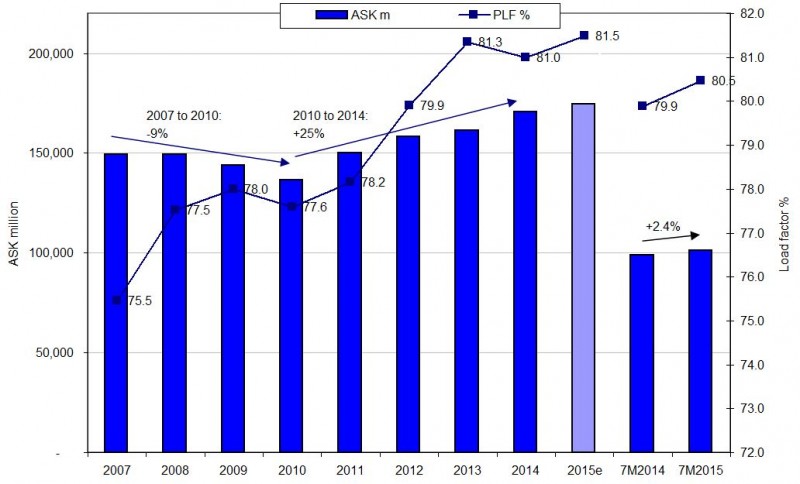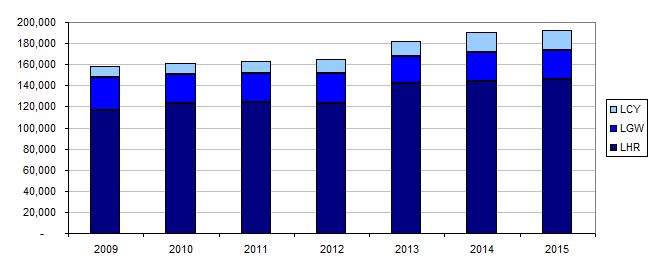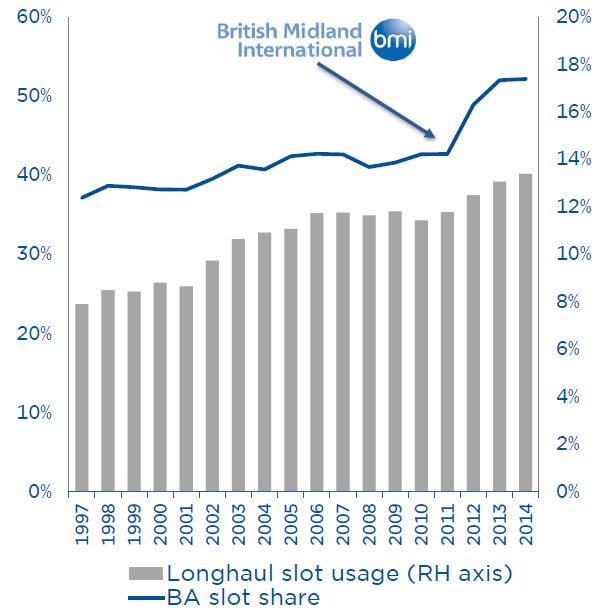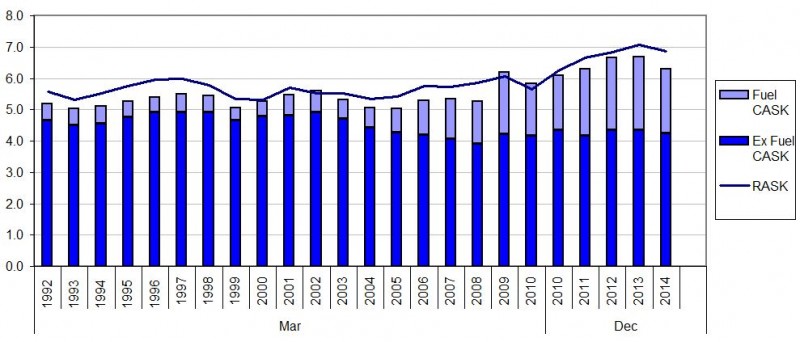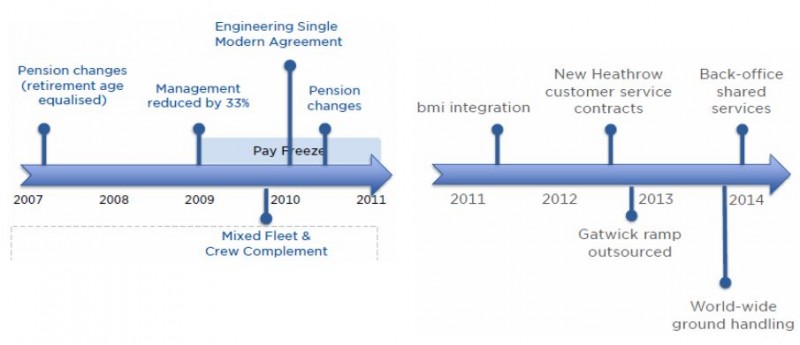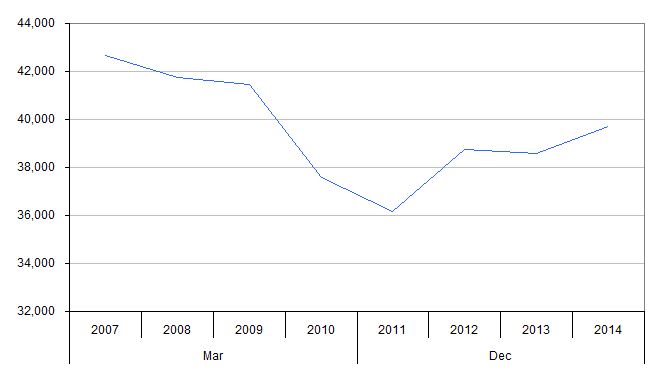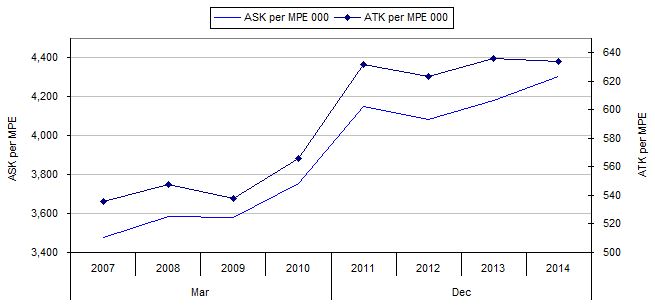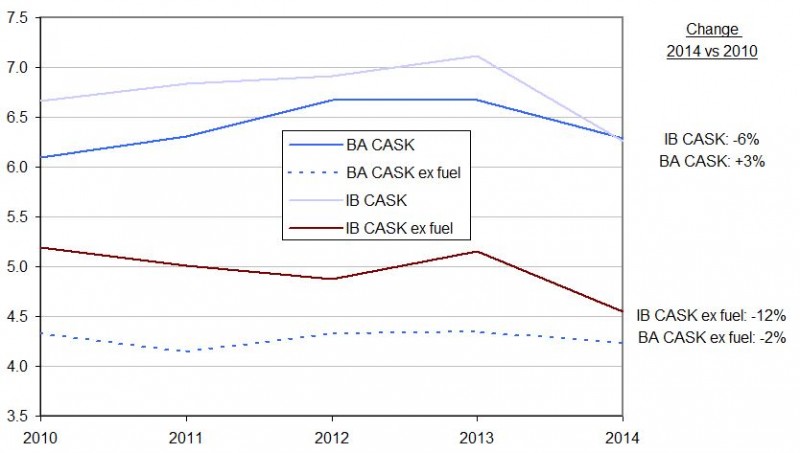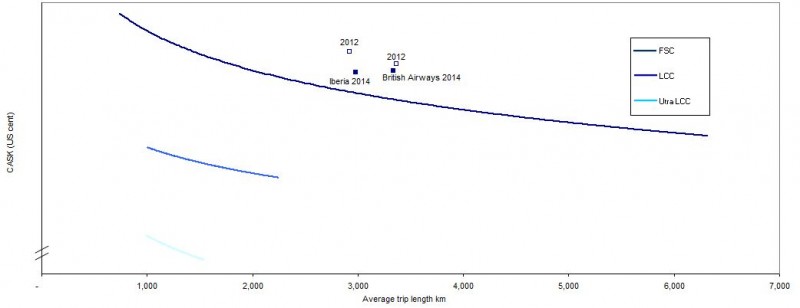British Airways: IAG's favourite child should follow reformed sister Iberia's unit cost example
In a May-2013 report on British Airways, we called it the favourite child of parent IAG. Its good behaviour was being rewarded with new fleet toys, while sister Iberia was scolded to mend its ways.
BA should match its best ever operating margin in 2015 and better it in 2016, even covering its cost of capital - a salutary model for its European counterparts. After the global financial crisis, margin recovery was mainly due to unit revenue growth. A RASK downturn in 2014 and 1H2015 has seen margins improve through lower unit cost, but these were largely thanks to lower fuel prices. Even a premium brand cannot always rely on unit revenue growth and BA still needs to cut CASK, with a focus on labour. It remains one of Europe's higher unit cost airlines and Iberia has cut CASK more successfully.
Iberia's reformed ways have been feted like the return of the prodigal and now BA has two more siblings. Up and coming teenager Vueling has been given significant trust and responsibility for one so young, while new arrival Aer Lingus will demand much parental attention. BA will need the maturity and determination of the eldest child to graduate to full value-creating adulthood.
See related reports:
British Airways: the parental favourite gets new toys, but still has homework to do
IAG's aircraft orders are like waiting for a bus. Three arrive at the same time.
IAG SWOT: Europe's leading legacy airline group shows financial progress and strategic confidence
IAG grows quarterly profit once more. Iberia long-haul growth to accelerate with additional aircraft
British Airways has increased capacity and load factor since the formation of IAG
After a period of contraction prompted by the financial crisis of 2008/2009, British Airways has enjoyed steady capacity growth since 2010. It cut its ASKs by 9% from the pre-crisis peak in 2007 to 2010, but then grew by 25% from 2010 to 2014. In 2014, BA's ASK growth rate was 5.9%, similar to its average rate through the 2010-2014 period.
For most of the time since the formation of IAG in early 2011, BA has grown faster than its sister company Iberia, where restructuring was the main priority until recently. However, for 2015, BA plans little more than 2% growth in ASKs, while Iberia will increase capacity by 10% this year as it restores routes suspended during its restructuring. BA's 2015 growth is driven by a combination of new routes (for example, Austin and Kuala Lumpur), a higher proportion of larger aircraft in the fleet and frequency increases, partly offset by discontinued routes and shorter sector length.
BA's capacity constraint following the financial crisis appears to have had a positive impact on its load factor, which climbed from 75.5% in 2007 to 78.2% in 2011, the first year of its merger with Iberia. During the recovery, stronger demand has driven load factor up further, reaching 81.3% in 2013, although there was a slight dip to 81.0% in 2014.
Year to date figures for 2015 show that this year's more modest rate of capacity growth boosted load factor by 0.6 ppts in the first seven months of the year, suggesting that BA could surpass its previous high of 81.3% for the full year.
British Airways available seat kilometres (ASK, million) and passenger load factor (%) 2007 to 2015e* and 7M2014 and 7M2015**
Heathrow is main driver of BA's growth since the formation of IAG
BA's growth since the formation of IAG has been driven mainly by expansion at its main hub at London Heathrow, where its slot holding in the summer season increased by 19% from 2010 to 2015, according to data from Airport Coordination Limited. At London Gatwick, BA's slot holding in summer 2015 is virtually unchanged from summer 2010 (following several years of decline prior to 2010).
BA's Heathrow slot growth was boosted substantially by IAG's acquisition of BMI, which took BA's share of slots at the airport from 44% in summer 2012 to 51% in summer 2013 (where it remains this summer). In addition, average aircraft size increased at London's biggest airport from 2010 to 2015, with seats per passenger air transport movements growing from 199 to 214 (summer seasons).
BA has increased its use of slots for long haul flights to just short of 14% of its Heathrow holding in 2014, up from 12% in 2010.
See related report: Heathrow Airport's slot machine: hitting the jackpot again?
BA's growth in the UK capital has also been boosted by a sharp increase in its presence at London City Airport, where its slot holding jumped by 85% from summer 2010 to summer 2015. LCY accounts for 10% of BA's London slots in summer 2015, compared with 6% in summer 2010. However, average aircraft size here is small: BA has an average of 83 seats per ATM at LCY.
See related report: London City Airport: the changing competitive landscape at the UK capital's most expensive airport
We estimate that City accounts for 5% of BA's London seats, Gatwick for 14% and Heathrow 82% in summer 2015. Heathrow has accounted for the vast majority of BA's incremental London seats since 2010.
British Airways air transport movements at London airports (Heathrow, Gatwick, City) summer season 2009 to 2015
British Airways share of air transport movements at London Heathrow (left hand axis) and proportion of BA slots used for long haul (right hand axis) summer season 1997 to 2014
BA's operating margin has recovered well from the losses of the global financial crisis…
The traffic recovery from the global financial crisis has also seen British Airways recover in profit terms. Adjusting its pre-IAG results, when it had a March year end, to conform with its current December year end reporting, BA's operating loss was GBP395 million in calendar 2009. This represented an operating margin of -4.9%, a rapid collapse from its pre-crisis peak of 8.4% in calendar 2007 (with BA's old March year end reporting, it achieved a best ever 10% margin in the year to Mar-2008).
Since returning to profit in 2010, BA's operating margin recovered to 8.3% in 2014, fractionally short of its 2007 peak. At IAG's Nov-2014 Capital Markets Day, BA reiterated a 2015 operating margin target of 10%, which would match its record margin on a financial year basis.
British Airways operating profit and operating margin calendar years 2007 to 2014*
…and is now approaching historic cyclical peak levels
Looking at BA's operating margin over a longer historical time frame, it is clear that, as with the airline industry as a whole, its profitability is highly cyclical (see chart below). Negative margins are rare and typically signal the trough of the cycle, while margins in the 8%-10% region are also rare and typically signal a cyclical peak.
However, under IAG, BA is now expected to maintain margins in the range of 10% to 14% and to generate a sustainable return on invested capital of 12% (above its cost of capital). This would mean a further margin improvement in 2015 and 2016.
British Airways operating profit margin FY1992 to FY2014*
The RASK versus CASK equation is at the heart of the matter
One of the keys to understanding this operating margin cycle is to look at the relative development of unit revenue (revenue per ASK, RASK) and unit cost (cost per ASK, CASK). When RASK is higher than CASK, the operating margin is positive and vice versa. In the period from FY1992 to FY2008 (March year end), both RASK and CASK remained in a fairly tight band of GBP5 pence to GBP6 pence.
The two metrics moved up and down broadly in synch, with RASK typically a little higher than CASK. In an upturn, RASK usually grew a little faster than CASK. In a downturn, RASK was not strong enough to offset an increase in CASK, or else CASK could not be cut fast enough to offset falling RASK.
Up until FY2002, variations in ex fuel CASK were the main cause of changes in total CASK, since fuel prices were relatively stable. Moreover, as CASK fluctuated, it appeared relatively easy to vary RASK in order to maintain a positive margin.
From FY2002, when BA fell into operating loss in the post 9/11 crisis, it began to make a concerted effort to reduce unit costs. BA's ex fuel CASK fell by 21% from FY2002 to FY2008, while fuel CASK more than doubled. For much of this period, RASK also increased as demand was strong and BA was able to introduce and then increase its fuel surcharge. These are the factors that drove BA to its record 10% operating margin in FY2008.
British Airways revenue per available seat km (RASK, GBPp) and cost per available seat km (CASK, GBPp) FY1992 to FY2014*
From record profit to record loss in one year, 2009/10; subsequent recovery mainly RASK-driven
However, BA fell from a record profit margin to record losses in the next two years, FY2009 and FY2010. The oil price spike of 2008 pushed up fuel CASK dramatically higher still in FY2009 and economic weakness meant that demand was not strong enough for BA to compensate with RASK. Moreover, the impressive reduction in ex fuel CASK that had been achieved during the previous years of capacity growth was reversed in both FY2009 and FY2010, when capacity was cut. Capacity cuts take out variable costs, but it is very difficult to trim fixed costs fast enough in a downturn.
BA's margin recovery since 2010 has mainly been driven by RASK growth outpacing CASK growth. Ex fuel CASK has not resumed its previous downward path, but has fluctuated annually without a clear trend. In 2014, RASK actually fell by 3%, but BA achieved margin expansion mainly thanks to a fall in fuel CASK, which helped total CASK to fall faster than RASK.
Labour is key to structural cost efficiency improvements
The traumatic experience of falling from record profit to record loss within 12 months prompted BA management to seek structural improvements in cost efficiency (and also gave further impetus to find a partner with whom it could join in the consolidation process in the European airline sector).
Fuel overtook labour as BA's biggest cost category in 2008, eventually pushing BA into a gradual fleet modernisation programme, which it expects to yield close to GBP400 million in cumulative annual fuel efficiency gains by 2020 versus 2012.
See related reports:
Does British Airways' 787 option conversion signal a return to a more expansionist capex policy?
IAG's aircraft orders are like waiting for a bus. Three arrive at the same time.
Fuel represented 33% of operating cost in 2014 (compared with 23% for labour). This at least has the merit of increasing the proportion of operating costs that are variable and therefore can be saved if capacity is cut. By contrast, labour (the second biggest cost category) has historically displayed the characteristics of a fixed cost: it must be paid regardless of activity levels.
This motivated management to seek more flexible labour practices with pay related more to activity and results. In addition to the potential cash savings latent within labour costs, an airline's employees are instrumental in implementing management's vision and in shaping the passenger's perception of the business. BA needed to seek changes to working practices, headcount reductions and labour productivity gains.
This led to a series of industrial agreements between 2007 and 2014, covering a wide range of HR-related issues. These included pension scheme changes, the reduction in management numbers by one third in 2009, lower pay and more flexible working conditions for new cabin crew from 2010 (working alongside incumbent crew under old contracts: the so-called "mixed fleet" arrangement that led to a series of damaging strikes), an updated engineering contract, the integration of bmi, new Heathrow customer service contracts in 2012 and the outsourcing of ramp handling at Gatwick
British Airways industrial agreements
Headcount reduction in the first decade of the century has turned to growth
In fact, BA had been reducing staff numbers for several years before the most recent global financial crisis, even before the events of 9/11 in 2001. Average manpower equivalents fell by 35% from a peak of 64,790 in FY2000 to 41,745 in FY2008, the year of the record 10% margin, although the rate of reduction had slowed since FY2005. Between the year to Mar-2008 and the year to Dec-2011, headcount fell by a further 13% to 36,164.
One of the enablers of this cut in staff numbers was BA's moving into its new home at Terminal 5 at Heathrow, where it is the sole occupant. BA's headcount at Heathrow was reduced by roughly 2,000 manpower equivalents (MPE) from Apr-2008 to Mar-2010. However, since the creation of IAG in 2011, BA's total staff numbers have started to rise again, reaching an average of 39,710 in calendar 2014.
British Airways average manpower equivalents FY2007 to FY2014*
Labour productivity is on an upward trend
BA's headcount reduction between FY2007 and FY2010 moved at a slightly faster pace than its reduction in ASKs, so that labour productivity measured in ASK per MPE improved by 7% over this three year period.
Since its return to capacity growth, headcount has risen at a slower rate. By FY2014, ASK per MPE had improved by a further 15% from FY2010.
British Airways ASK and ATK per manpower equivalent ('000) FY2007 to FY2014*
BA expects further gains in labour productivity and efficiency in the years to come. Its estimate of the cumulative annual benefit of its "mixed fleet" changes to cabin crew arrangements, introduced in 2010, is that it will reach GBP100 million after ten years. Headcount in its Heathrow customer services operation is projected to fall by 10% from 2014 to 2020, when two thirds of staff in this area are expected to be on the new lower cost and more flexible contract.
In the Engineering function, BA plans to lower headcount by 2.5% from 2016 to 2019 and to bring pay into line with market rates by 2020. It has also taken steps to improve pilot productivity.
As a result of its initiatives in labour practices, BA projects that ASK per MPE will increase by 10% to 15% in 2020 versus its 2014 level. Its track record lends credibility to its target, since ASK per MPE increased by around 50% from 2001 to 2013
British Airways ASK per manpower equivalent (indexed to 100 in 2001) 2001 to 2013 and projection to 2020
But the trend of labour CASK is less clear
Of course, improvements in productivity in terms of ASK per MPE are important, but, ultimately, it is labour cost per ASK (labour CASK) that really matters to profitability. Productivity gains often come at the expense of higher labour cost per employee, which can then offset those gains when it comes to labour CASK. Relative to the last pre-crisis year, FY2008, BA's labour CASK in 2014 was lower by only 2% and it has fluctuated with no clear trend in the intervening period.
Indeed, over a longer time period, labour CASK has changed little. It was at the same level in 2014 as in FY1999, in spite of a 66% improvement in ASK per MPE (source: CAPA analysis of BA annual reports).
BA's many labour restructuring initiatives of recent years should lead to improvements in labour CASK in the future, but an explicit target on labour CASK has not been published. This is in contrast with Iberia, which plans to lower its labour CASK by 35% in 2020 from its 2012 level.
British Airways labour cost* per ASK (GBPp) FY2007 to FY2014**
British Airways has not had the same success as Iberia with CASK reduction since 2010
As noted above, BA's margin recovery since the global financial crisis was initially driven by RASK increases. In 2014, RASK turned down, but BA's operating margin benefited from a larger fall in CASK, which itself owed much to lower fuel prices.
The big test for any restructured business is how it performs in a cyclical downturn and this means maintaining profitability when unit revenue slumps and without relying on lower fuel prices. In turn, this means driving ex fuel CASK down as far as possible.
Since the merger with Iberia to form IAG, BA's track record on CASK is inferior to that of its Spanish sister company. Relative to 2010, the final year before the merger, BA's 2014 CASK was up 3%, while Iberia's CASK (translated into GBP) was down 6%.
Stripping out the vagaries of fuel price fluctuations, BA's 2014 ex fuel CASK was 2% below its 2010 level, compared with a 12 % reduction at Iberia (calculated in GBP terms; translating both into EUR, BA's ex fuel CASK was up by 4% and Iberia's down 7% in 2014 relative to 2010).
British Airways and Iberia cost per available seat km (CASK, GBPp) 2010 to 2014
British Airways and Iberia revenue per available seat km (RASK, GBPp) 2010 to 2014
BA is still among Europe's higher unit cost airlines
The chart below shows the trend lines generated as lines of best fit through a scatter plot of CASK (translated into USc, vertical axis) versus average trip length (horizontal axis) for European airlines in 2014. The airlines are grouped into three categories, full service carriers, low cost carriers and ultra low cost carriers, with a trend line for each category. The individual data points have been removed from the chart, with the exception of the points for BA and Iberia. Data points are also shown for the two original IAG airlines for 2012.
The chart highlights two things. First, BA is above the FSC trend line, grouping it with Europe's higher cost legacy airlines (ie its CASK remains relatively high for its average trip length), even after a number of years of labour restructuring. The same is also true of Iberia, but the Spanish airline has made greater progress in lowering CASK from 2012 to 2014. (Moreover, BA has a higher average trip length and so, all other things being equal, it should have a lower CASK than Iberia's.)
This brings us to the second point highlighted by the chart and already made above. This is that BA has made only slow progress in CASK reduction over the past two years. Its CASK fell in 1H2015, helped by lower fuel prices, but so did RASK (both in GBP terms).
Unit cost (cost per available seat kilometre, US cent) versus average trip length for European full service carriers, low cost carriers and ultra low cost carriers 2014
BA must now drive labour CASK reduction
While BA has not done as well as Iberia in lowering unit cost since the creation of IAG, it has done better than Iberia with increasing unit revenue. However, unit revenue is now falling and it cannot be relied upon to grow year after year, even taking account of product and service improvements.
If BA is to continue to improve its profit margin in a falling RASK environment, and without relying on lower fuel prices, it must re-establish a clear downward path for ex fuel CASK.
An important step to achieving a downward path for ex fuel unit cost will be to ensure that labour CASK reductions can flow from labour productivity improvements. Achieving labour cost efficiency gains can be a slow process, but BA has laid the ground work over a number of years. It is now time to deliver.
